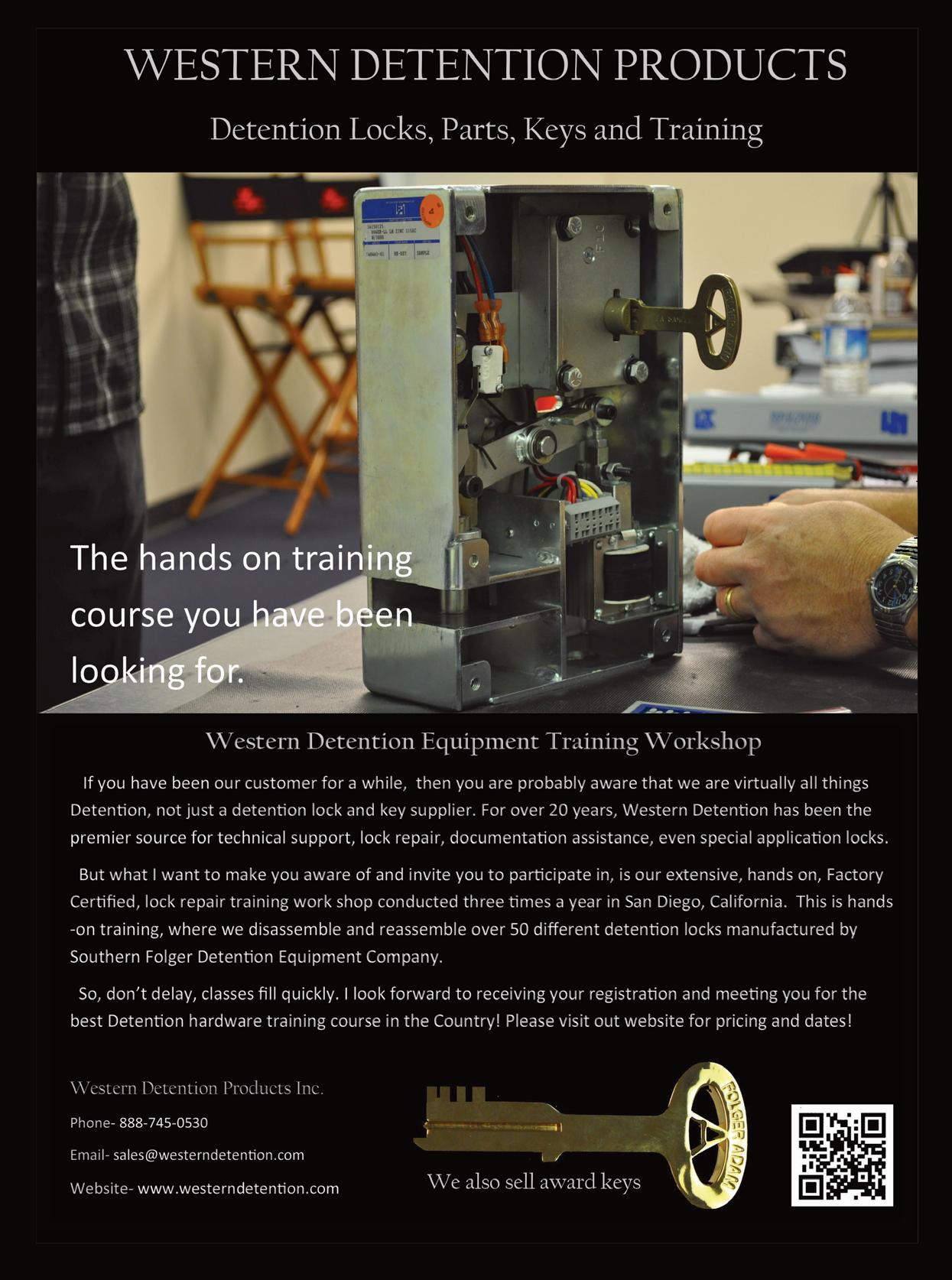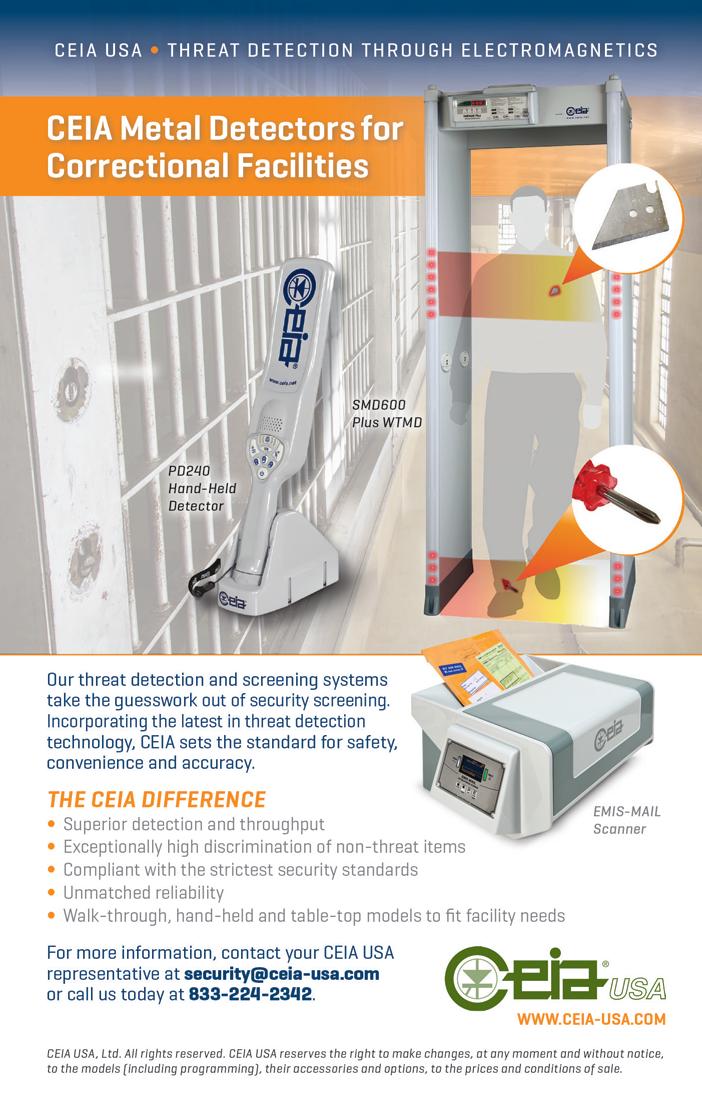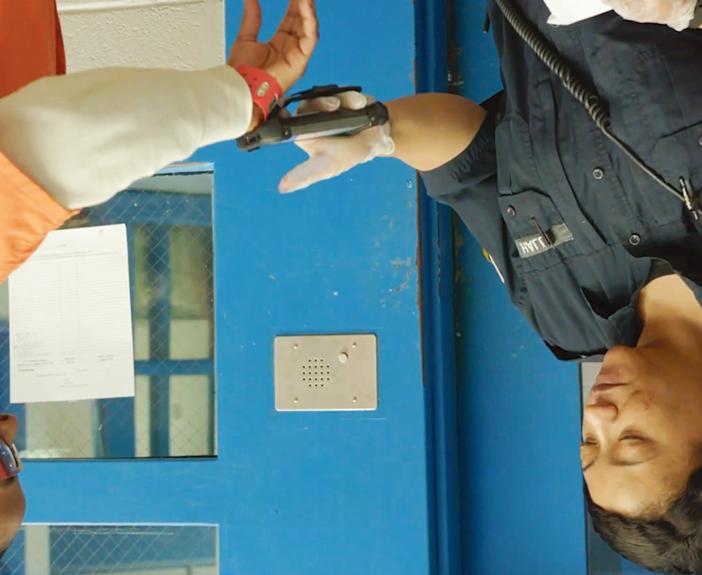
11 minute read
Advancements That Multiply Your Security Workforce
Security Force Multipliers
Multiply your security forces with the latest advancements in software and hardware.
Advertisement
eginning with software that analyzes data to ensure safety and alleviate threats, then going through the facility to find electronic tracking devices that constantly locate inmates, staff and objects, and ending at the fence with perimeter intrusion hardware, these safety measures multiply security factors exponentially.
To start inside—not even the facility, but the inmates’ heads— means gathering information needed to best keep them, staff and visitors safe. The information combined with analytics can be used to assign housing, classify threat levels, and direct allowable movement and programs, all of which lead to greater safety overall.
Security enhancement is one of the main motivations behind optimizing the assignment of the inmates at a correctional system, says Mohammad Shahabsafa. As B
the CEO he says Optamo has developed what it describes as the first-of-its-kind inmate assignment decision support system (IADSS). The analytics enable a correctional agency to consider a multitude of factors affecting the assignment of inmates and scheduling their rehabilitation program.
IADSS considers all the demographic information of the inmates and enforces all the inmate-inmate and inmate-staff separations, he explains, which in turn reduces the number of assaults within the facilities. Anshul Sharma, chief technology officer, delineates that IADSS can factor the distribution of each of the prominent gangs at the facilities. “By defining the ideal distribution of gang populations, IADSS works to minimize the deviation from the ideal distribution. This in turn helps to reduce gang-related activities that adversely impact the security of the facilities.” And since inmate transportation is one of riskiest operations of a correctional system, he attests, by considering the needs of the inmates upfront IADSS also helps facilities reduce inmate transports.
President Tamás Terlaky presents real-life scenarios based on the IADSS implementation at the Pennsylvania Department of Corrections (PADOC) since 2016. “More than 40,000 inmates are so far assigned to State Correctional Institutions (SCIs) through IADSS. It has assisted the PADOC to reduce inmate transportations by 35 percent since 2016 and has led to significant reduction in the number of assaults within the SCIs.”
Expanding on comprehensive data collection usage, equivant/Northpointe provides classification and management programs to improve security.


Snapshot of the Inmate Assignment Decision Support System (IADSS), a webbased system that assigns inmates and schedules treatment programs.
Manager Greg Eash describes its objective classification of inmates which is backed by its nationallyrecognized Decision Tree.
“Classification is essential to the operation of an orderly and safe jail and it’s a prerequisite for meaningful program planning for your inmates.” Northpointe Suite Classification is an evidencebased tool that considers staff and inmate safety, public safety, orderly and equitable processing, and compliance with inmate’s rights, protecting against potential litigation. “Objective classification helps identify specialized circumstances, mental health issues, keep-away considerations, etc., and provides your staff with a rational basis for their decisions.” Another program offered, Northpointe Suite Custody Management, provides a platform to manage all aspects of facility operations and oversight. Bringing together data analytics, policy compliance, and decision support, Eash says it includes all the tools needed for objective inmate classification; compliancy tools for PREA; pretrial management; screeners for mental health, suicide, and PTSD; program eligibility criteria; complete resident tracking and progress; risk/needs assessments and reentry planning and management.
He adds that based on years of experience, in an effort to assist jails in building their own evidence-based environment and inmate behavior management plan, equivant/Northpointe hosts focused workshops throughout the U.S. to help educate jails that have, or are considering, implementing a Classification unit.
After collecting data to assign and classify inmates and manage all aspects of custody, technology
How Inmate Tracking Works Based on the TSI PRISM System manufactured by Black Creek Integrated Systems

In deploying this type of technology, the subjects or objects users desire to track are equipped with body-worn or device-attached RFID tags. Subjects are mapped to unique tag I.D.s in the application software. The tags transmit a signal at configurable intervals consisting of packets of data that provide information about the tag. Examples of tag information include the tag’s unique I.D., the condition of its battery, whether the tag is moving, and, depending on the type of tag, whether it is installed properly on the wearer. In the case of the TSI PRISM Inmate Tag, the heart rate of the wearer is also included in the data packet and transmitted at user-configurable intervals.
Tag signals are received by multiple location receivers which calculate the angle of arrival of the signal at the receiver and transmit that information, along with the information in the tag’s data packet,
over the system’s dedicated Ethernet network to a location engine executing on a dedicated location server. In Black Creek’s case, the location engine calculates the location of the tag in the facility in three axes with accuracies that range typically
from one to two meters with available sub-meter accuracy if required. The tag’s location and data are transmitted to an application server executing the software.
On receipt of tag information from the positioning engine, software stores the location of the tag in a Microsoft SQL Server database for display and later analysis.
—Ike Newton, president, Black Creek Integrated Systems Black Creek’s TSI PRISM Inmate Tag secures with a stainless-steel clasp that requires a special tool for removal. Device removal or heart rate excursions above/below individual-configurable levels annunciates an alarm on workstations.
advancements leave the desk and travel the halls to impact electronic tracking. “Imagine that you could know the location of every officer in an emergency, and have a 100 percent accurate history of every inmate movement within your facility—automatically,” describes Stephanie Barsella, national sales manager at Guard1—"plus complete, accurate documentation of every officer task and inmate activity.”
Barsella explains: Officers, staff, and inmates have RF tags that transmit a signal once per second. The Guard1 system offers various types of wristband devices, ID badges, and personal alarms, that work with the system's receivers. Facilities can tag equipment, tools, and even kitchen utensils. Automatic inmate location technology also means immediate detection of keep-separate violations, she notes. Guard1 gets this information from its integration with the facility's offender management system, and signals an alert when designated individuals or groups are in the same zone.
Benefits go beyond just tracking, she clarifies. Guard1 tags include a RFID tag that's readable with a smart mobile device. "Headcounts, meals, well-being checks, duty logs—all these are necessary but time-consuming tasks for officers and staff," says Barsella, “but Guard1 mobile devices take seconds to document." Notifications to administrators and supervisors is another much-appreciated benefit, she adds. Supervisors get e-mail or text notification of missed checks, alerts and other issues— direct to their mobile phones.
The word mobile is key, according to Ken Dalley’s description of what SPARTAN can do as part of GUARDIAN RFID. Calling himself “Chief Warrior” there, he details mobile inmate tracking with an Android device running Mobile Command and managing a wide range of responsibilities.
“Mobile inmate tracking helps officers to identify offenders electronically, and collect data about what you see them doing, where you take them, and what you give them instantly,” Dalley affirms. GUARDIAN RFID translates these large data sets into actionable insights for staff, at every level, using Operational Intelligence, the secure, cloudbased business intelligence layer of GUARDIAN RFID.
“Mobile Inmate Tracking by GUARDIAN RFID is a force multi
plier, helping teams work faster by eliminating manual logging that results in incomplete or inconsistent records, poor communication, and lack of staff accountability,” he says. Mobile inmate tracking streamlines processes, accelerates data collection and reporting, and optimizes accountability and security at all levels.
Several features highlight safety aspects. Critical information can be lost in translation, Dalley says, the use of Google Translate


on the mobile device allows for immediate open communication necessary to keep both staff and inmates informed and safe. And features such as video and photo capture evidence.
With video, for instance, users can capture sight and sound to record non-compliant and threatening inmate behaviors, cell extractions, and more. With still images, users can log contraband during cell checks at the point of responsibility. He furthers that users are able to “securely view images and videos taken by staff for digital evidence from any device, including [a] smartphone, tablet, or workstation, with legally defensible data that cannot be modified, edited or deleted.”
The combination of tracking hardware and software has accelerated a world of possible advancements in the field. Says Ike Newton, president of Black Creek, “Of the many new technologies that have impacted corrections since the ’90s, none have had the potential to reduce the risks and costs associated with operating a correctional facility as Real-Time Locating System (RTLS) technology.”
Whether inmate or staff, he
Guard1 inmate wristbands send a tracking ping every second.

expounds, it is the nature of most humans to conform their behavior to established norms when they know that there is continuous oversight of their actions and that retribution will swiftly and consistently follow any misbehavior. “Based on that simple premise, an agency’s ability to precisely track and record the location of inmates and staff and analyze their movement histories over time has proven to have a significant beneficial impact on correctional facility operation.”
In 2020, as the result of advancements in technology, Black Creek introduced a new generation of TSI PRISM RTLS which addressed initial introductory issues from the ’90s. The new generation includes a device the size of a watch with functionality that includes heart-rate monitoring and a battery life that can last up to five years. The new technology increased tracking precision with available submeter accuracy that provides improved reporting including the ability to produce out-of-cell time summaries for inmates and the ability to perform watch tours without scanning fixed location devices. And the last change from the introductory products is a price point approximately half the cost of previous systems, Newton points out.
“When one stops to think about what can be done with the location data produced by coordinate-based RTLS systems, the uses are limited only by one’s imagination,” he says. Some of the more obvious benefits, he summarizes: Improved overall safety from reduction of assaults, improved staff safety, potential for reduction of in-custody

deaths due to ill-health or suicide, increased PREA compliance, reduction in use of force incidents, reduction in the length and cost of investigations, instantaneous headcounts, automated watch tours, reduced risk of exposure to lawsuits, and reduced risk of escape.
The escape risk—as its own security battle—takes us to the edge of the facility’s protection zone, the perimeter. While inmates and their cohorts seem to constantly ratchet up their ploys for escape attempts, the continued improvements in technology surpass them. In recent years, Senstar has introduced several new technologies that change the security landscape, explains Stewart Dewar, product manager.
Advances in embedded processing and communication technology have led to the adoption of new detection techniques (time-domain reflectometry and accelerometers, for example) for use in fence-mounted sensors. “These advances allow for highlyvalued features like environmental compensation algorithms, precision ranging, cut immunity, and low-voltage power over sensor cables to reduce electrical infrastructure costs.”
Video analytics have greatly improved over recent years, he notes, benefiting from today's higher performance/lower cost computing resources, as well as HD cameras with impressive lowlight, IR and thermal capabilities. Advances in computer vision research have led to the development of sophisticated video analytic software optimized for outdoor/indoor people tracking, left/removed object detection, auto PTZ, face and license plate recognition, crowd detection, and much more. These software modules may be included as part of a Video Management System (VMS) or embedded on individual cameras.
Another technology improvement is the widespread adoption
Inmate-specific data on supplies, including hazardous items such as razors, can be captured with a mobile device and shared between mobile devices using Guardian RFID.

of LED-based, low-voltage lighting, Dewar describes. When installed along the perimeter, LED-based luminaires can provide illumination along the fence line, which improves video assessment capabilities while dramatically reducing electrical consumption and maintenance costs.
“Bringing intelligence to the perimeter enables new applications and enhanced multi-layer security, especially when video analytics are deployed alongside perimeter sensors,” he says. For example, consider a facility where a people-tracking analytic monitors the areas both inside and outside the perimeter fence. Under normal operation, Dewar relates, the video surveillance system records a low-bandwidth stream. When the analytic detects the movement of people near the fences, the software switches to a higher-quality stream and increases the intensity of the perimeter lighting. The improved lighting maximizes the performance of the analytic software and ensures potential events are recorded (and ideally deterred) well before an intrusion is attempted. He adds, “A force multiplier, Senstar technology frees up officer resources and alerts staff to inmate escape attempts.”
The perimeter intrusion technology, as well as other mentioned advancements, such as inmate assigning and classifying, custody management, and electronic tracking, are truly tools that are force multipliers for the forward-thinking corrections administrator and supervisor. ✪
For more information: Senstar Corporation, 613.839-5572, sdewar@senstar.com GUARDIAN RFID, 855.777-7343, Info@GuardianRFID.com, GuardianRFID.com equivant/Northpointe, info@equivant.com, www.equivant.com Guard1, Stephanie Barsella, sbarsella@guard1.com Optamo, info@optamo-llc.com Black Creek, www.blackcreekisc.com








